Sales Techniques: Overcoming Objections and Closing Sales
VerifiedAdded on 2023/04/17
|6
|918
|90
AI Summary
This document discusses five techniques for overcoming objections in sales, including gratitude, emphasizing customer care, starting the discovery process, asking, proving, and confirming, and showing the value of the product. It also covers five techniques for closing sales, such as the never or now close, summary close, sharp angle close, question close, and assumptive close.
Contribute Materials
Your contribution can guide someone’s learning journey. Share your
documents today.

Running head: SALES TECHNIQUES
Sales techniques
Name of the student:
Name of the university:
Author note:
Sales techniques
Name of the student:
Name of the university:
Author note:
Secure Best Marks with AI Grader
Need help grading? Try our AI Grader for instant feedback on your assignments.
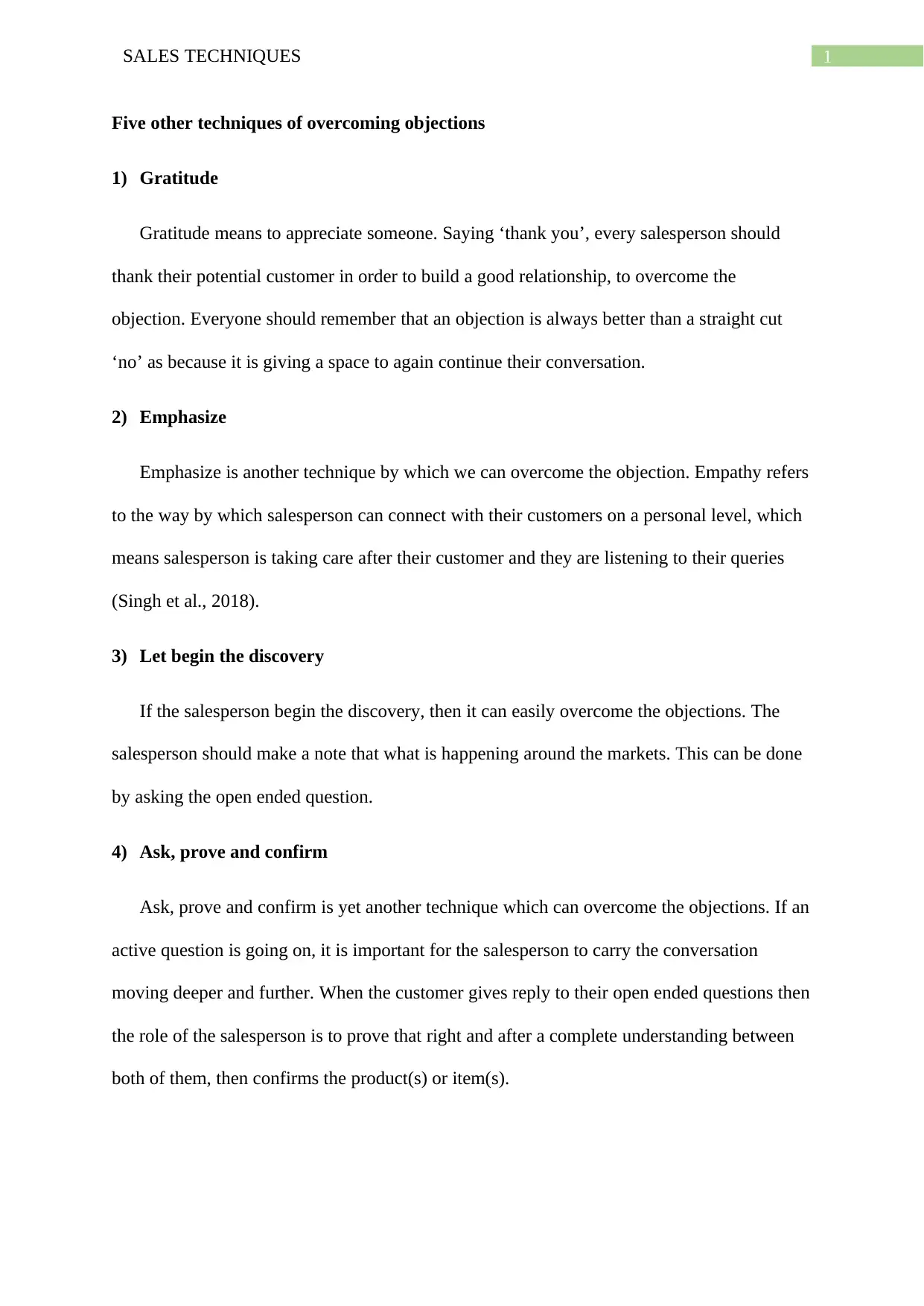
1SALES TECHNIQUES
Five other techniques of overcoming objections
1) Gratitude
Gratitude means to appreciate someone. Saying ‘thank you’, every salesperson should
thank their potential customer in order to build a good relationship, to overcome the
objection. Everyone should remember that an objection is always better than a straight cut
‘no’ as because it is giving a space to again continue their conversation.
2) Emphasize
Emphasize is another technique by which we can overcome the objection. Empathy refers
to the way by which salesperson can connect with their customers on a personal level, which
means salesperson is taking care after their customer and they are listening to their queries
(Singh et al., 2018).
3) Let begin the discovery
If the salesperson begin the discovery, then it can easily overcome the objections. The
salesperson should make a note that what is happening around the markets. This can be done
by asking the open ended question.
4) Ask, prove and confirm
Ask, prove and confirm is yet another technique which can overcome the objections. If an
active question is going on, it is important for the salesperson to carry the conversation
moving deeper and further. When the customer gives reply to their open ended questions then
the role of the salesperson is to prove that right and after a complete understanding between
both of them, then confirms the product(s) or item(s).
Five other techniques of overcoming objections
1) Gratitude
Gratitude means to appreciate someone. Saying ‘thank you’, every salesperson should
thank their potential customer in order to build a good relationship, to overcome the
objection. Everyone should remember that an objection is always better than a straight cut
‘no’ as because it is giving a space to again continue their conversation.
2) Emphasize
Emphasize is another technique by which we can overcome the objection. Empathy refers
to the way by which salesperson can connect with their customers on a personal level, which
means salesperson is taking care after their customer and they are listening to their queries
(Singh et al., 2018).
3) Let begin the discovery
If the salesperson begin the discovery, then it can easily overcome the objections. The
salesperson should make a note that what is happening around the markets. This can be done
by asking the open ended question.
4) Ask, prove and confirm
Ask, prove and confirm is yet another technique which can overcome the objections. If an
active question is going on, it is important for the salesperson to carry the conversation
moving deeper and further. When the customer gives reply to their open ended questions then
the role of the salesperson is to prove that right and after a complete understanding between
both of them, then confirms the product(s) or item(s).
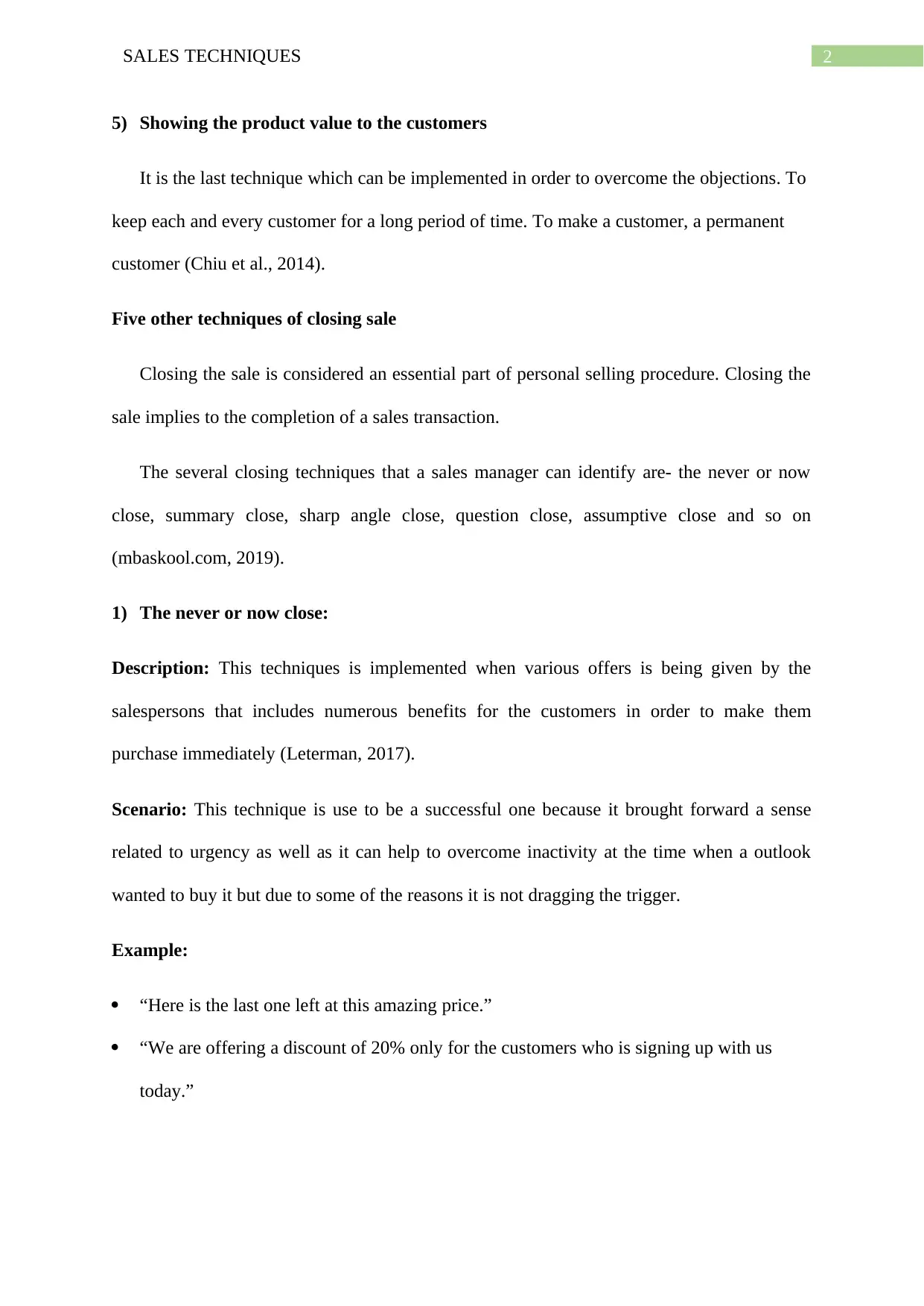
2SALES TECHNIQUES
5) Showing the product value to the customers
It is the last technique which can be implemented in order to overcome the objections. To
keep each and every customer for a long period of time. To make a customer, a permanent
customer (Chiu et al., 2014).
Five other techniques of closing sale
Closing the sale is considered an essential part of personal selling procedure. Closing the
sale implies to the completion of a sales transaction.
The several closing techniques that a sales manager can identify are- the never or now
close, summary close, sharp angle close, question close, assumptive close and so on
(mbaskool.com, 2019).
1) The never or now close:
Description: This techniques is implemented when various offers is being given by the
salespersons that includes numerous benefits for the customers in order to make them
purchase immediately (Leterman, 2017).
Scenario: This technique is use to be a successful one because it brought forward a sense
related to urgency as well as it can help to overcome inactivity at the time when a outlook
wanted to buy it but due to some of the reasons it is not dragging the trigger.
Example:
“Here is the last one left at this amazing price.”
“We are offering a discount of 20% only for the customers who is signing up with us
today.”
5) Showing the product value to the customers
It is the last technique which can be implemented in order to overcome the objections. To
keep each and every customer for a long period of time. To make a customer, a permanent
customer (Chiu et al., 2014).
Five other techniques of closing sale
Closing the sale is considered an essential part of personal selling procedure. Closing the
sale implies to the completion of a sales transaction.
The several closing techniques that a sales manager can identify are- the never or now
close, summary close, sharp angle close, question close, assumptive close and so on
(mbaskool.com, 2019).
1) The never or now close:
Description: This techniques is implemented when various offers is being given by the
salespersons that includes numerous benefits for the customers in order to make them
purchase immediately (Leterman, 2017).
Scenario: This technique is use to be a successful one because it brought forward a sense
related to urgency as well as it can help to overcome inactivity at the time when a outlook
wanted to buy it but due to some of the reasons it is not dragging the trigger.
Example:
“Here is the last one left at this amazing price.”
“We are offering a discount of 20% only for the customers who is signing up with us
today.”
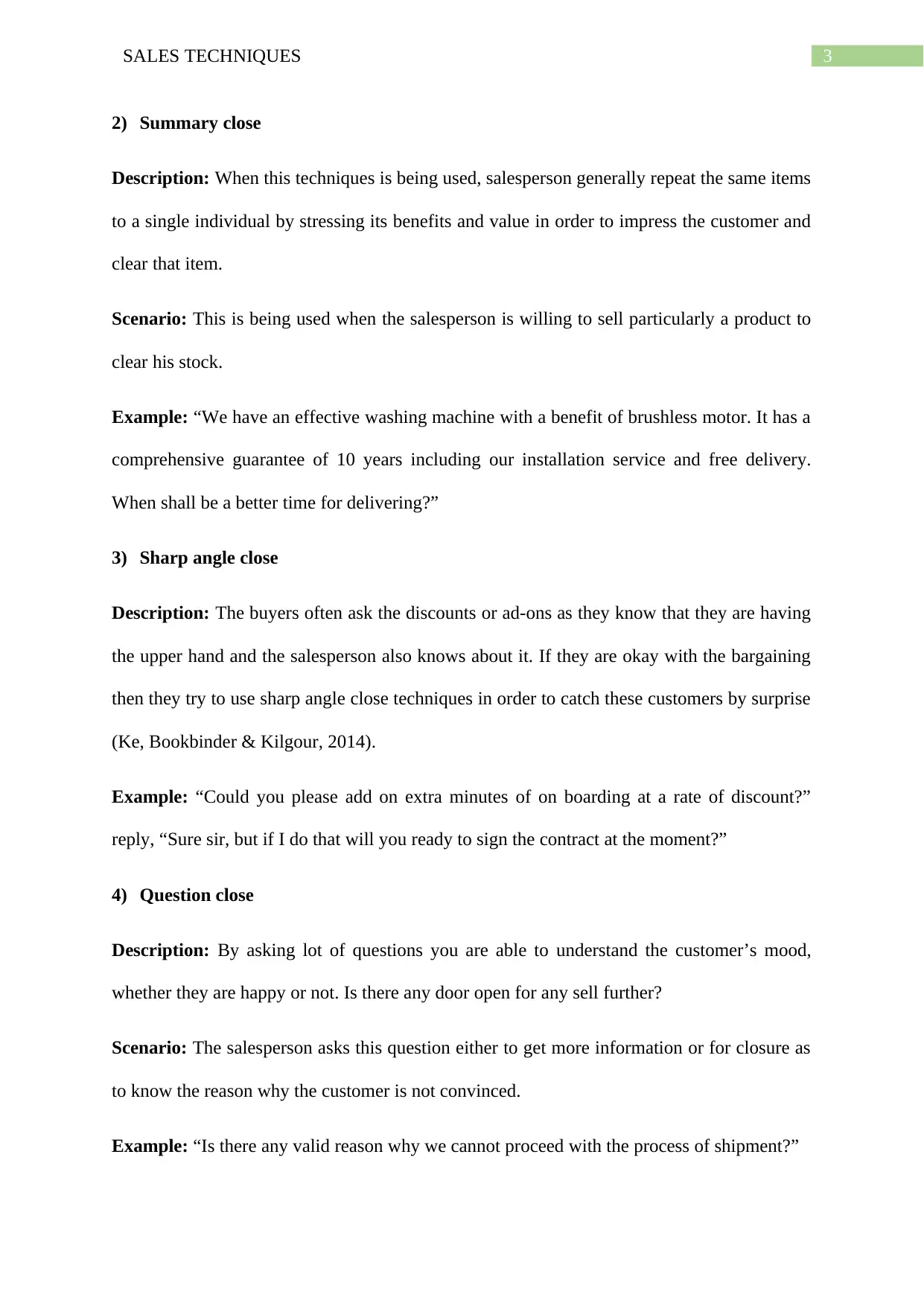
3SALES TECHNIQUES
2) Summary close
Description: When this techniques is being used, salesperson generally repeat the same items
to a single individual by stressing its benefits and value in order to impress the customer and
clear that item.
Scenario: This is being used when the salesperson is willing to sell particularly a product to
clear his stock.
Example: “We have an effective washing machine with a benefit of brushless motor. It has a
comprehensive guarantee of 10 years including our installation service and free delivery.
When shall be a better time for delivering?”
3) Sharp angle close
Description: The buyers often ask the discounts or ad-ons as they know that they are having
the upper hand and the salesperson also knows about it. If they are okay with the bargaining
then they try to use sharp angle close techniques in order to catch these customers by surprise
(Ke, Bookbinder & Kilgour, 2014).
Example: “Could you please add on extra minutes of on boarding at a rate of discount?”
reply, “Sure sir, but if I do that will you ready to sign the contract at the moment?”
4) Question close
Description: By asking lot of questions you are able to understand the customer’s mood,
whether they are happy or not. Is there any door open for any sell further?
Scenario: The salesperson asks this question either to get more information or for closure as
to know the reason why the customer is not convinced.
Example: “Is there any valid reason why we cannot proceed with the process of shipment?”
2) Summary close
Description: When this techniques is being used, salesperson generally repeat the same items
to a single individual by stressing its benefits and value in order to impress the customer and
clear that item.
Scenario: This is being used when the salesperson is willing to sell particularly a product to
clear his stock.
Example: “We have an effective washing machine with a benefit of brushless motor. It has a
comprehensive guarantee of 10 years including our installation service and free delivery.
When shall be a better time for delivering?”
3) Sharp angle close
Description: The buyers often ask the discounts or ad-ons as they know that they are having
the upper hand and the salesperson also knows about it. If they are okay with the bargaining
then they try to use sharp angle close techniques in order to catch these customers by surprise
(Ke, Bookbinder & Kilgour, 2014).
Example: “Could you please add on extra minutes of on boarding at a rate of discount?”
reply, “Sure sir, but if I do that will you ready to sign the contract at the moment?”
4) Question close
Description: By asking lot of questions you are able to understand the customer’s mood,
whether they are happy or not. Is there any door open for any sell further?
Scenario: The salesperson asks this question either to get more information or for closure as
to know the reason why the customer is not convinced.
Example: “Is there any valid reason why we cannot proceed with the process of shipment?”
Secure Best Marks with AI Grader
Need help grading? Try our AI Grader for instant feedback on your assignments.
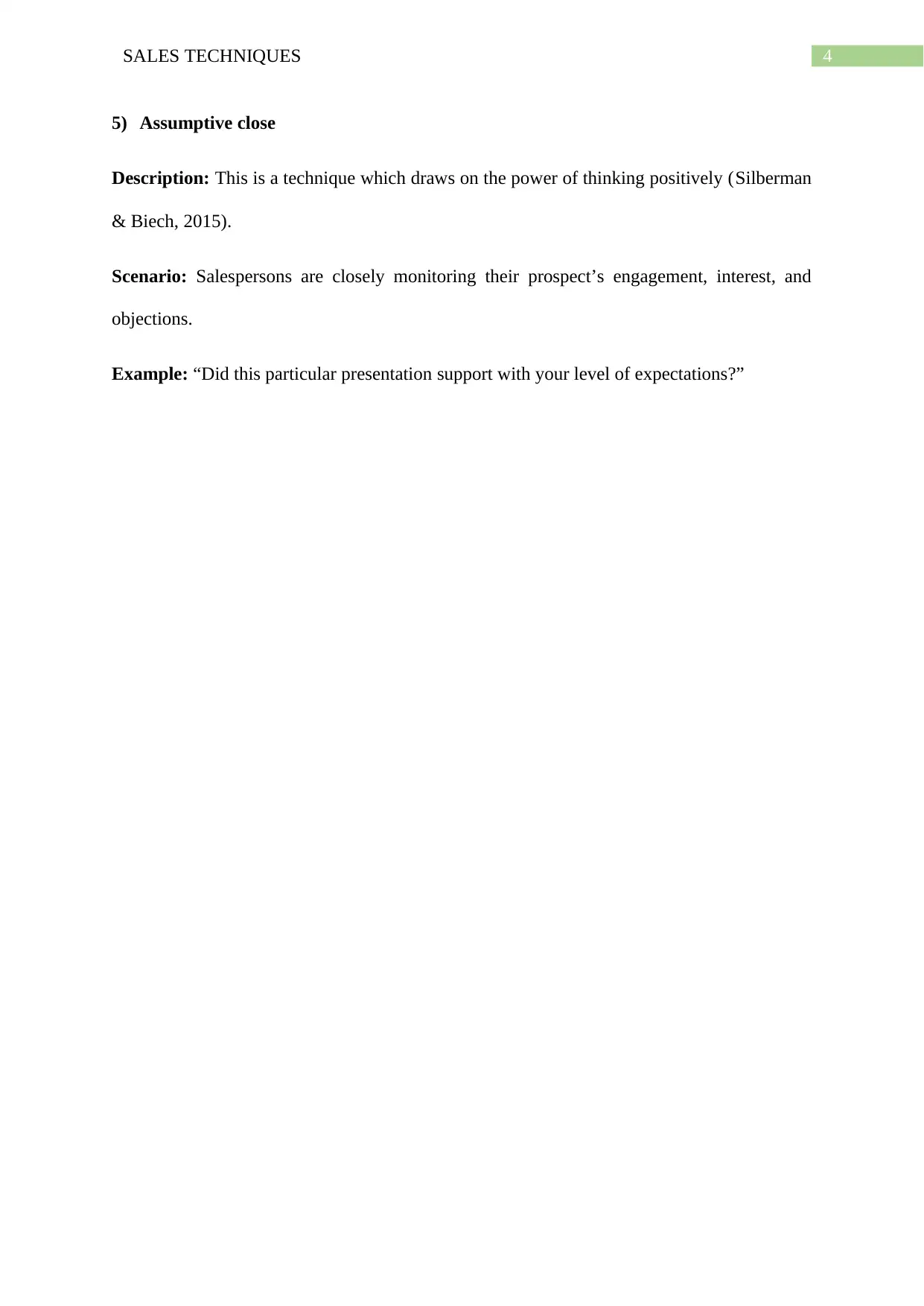
4SALES TECHNIQUES
5) Assumptive close
Description: This is a technique which draws on the power of thinking positively (Silberman
& Biech, 2015).
Scenario: Salespersons are closely monitoring their prospect’s engagement, interest, and
objections.
Example: “Did this particular presentation support with your level of expectations?”
5) Assumptive close
Description: This is a technique which draws on the power of thinking positively (Silberman
& Biech, 2015).
Scenario: Salespersons are closely monitoring their prospect’s engagement, interest, and
objections.
Example: “Did this particular presentation support with your level of expectations?”
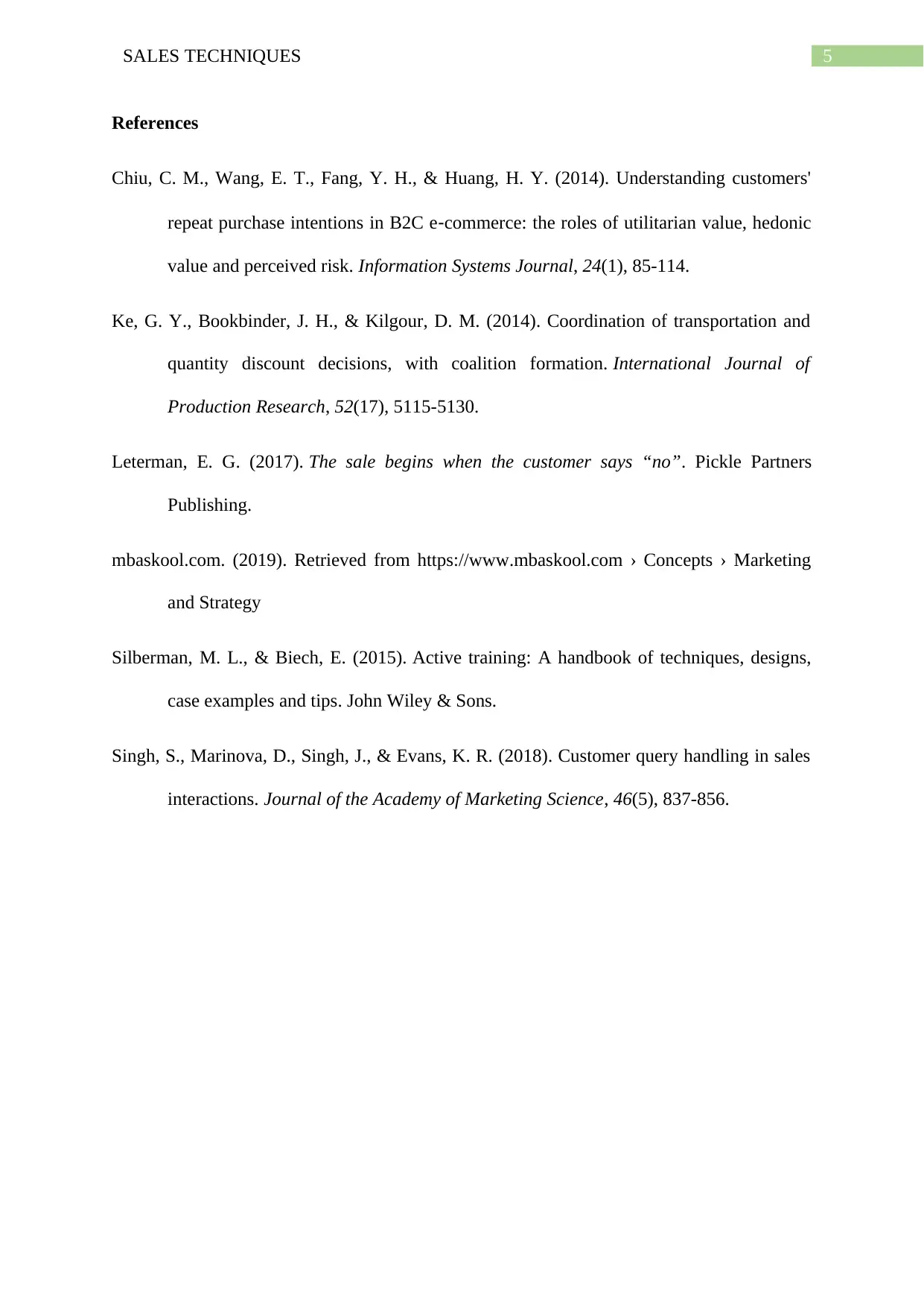
5SALES TECHNIQUES
References
Chiu, C. M., Wang, E. T., Fang, Y. H., & Huang, H. Y. (2014). Understanding customers'
repeat purchase intentions in B2C e‐commerce: the roles of utilitarian value, hedonic
value and perceived risk. Information Systems Journal, 24(1), 85-114.
Ke, G. Y., Bookbinder, J. H., & Kilgour, D. M. (2014). Coordination of transportation and
quantity discount decisions, with coalition formation. International Journal of
Production Research, 52(17), 5115-5130.
Leterman, E. G. (2017). The sale begins when the customer says “no”. Pickle Partners
Publishing.
mbaskool.com. (2019). Retrieved from https://www.mbaskool.com › Concepts › Marketing
and Strategy
Silberman, M. L., & Biech, E. (2015). Active training: A handbook of techniques, designs,
case examples and tips. John Wiley & Sons.
Singh, S., Marinova, D., Singh, J., & Evans, K. R. (2018). Customer query handling in sales
interactions. Journal of the Academy of Marketing Science, 46(5), 837-856.
References
Chiu, C. M., Wang, E. T., Fang, Y. H., & Huang, H. Y. (2014). Understanding customers'
repeat purchase intentions in B2C e‐commerce: the roles of utilitarian value, hedonic
value and perceived risk. Information Systems Journal, 24(1), 85-114.
Ke, G. Y., Bookbinder, J. H., & Kilgour, D. M. (2014). Coordination of transportation and
quantity discount decisions, with coalition formation. International Journal of
Production Research, 52(17), 5115-5130.
Leterman, E. G. (2017). The sale begins when the customer says “no”. Pickle Partners
Publishing.
mbaskool.com. (2019). Retrieved from https://www.mbaskool.com › Concepts › Marketing
and Strategy
Silberman, M. L., & Biech, E. (2015). Active training: A handbook of techniques, designs,
case examples and tips. John Wiley & Sons.
Singh, S., Marinova, D., Singh, J., & Evans, K. R. (2018). Customer query handling in sales
interactions. Journal of the Academy of Marketing Science, 46(5), 837-856.
1 out of 6
Your All-in-One AI-Powered Toolkit for Academic Success.
+13062052269
info@desklib.com
Available 24*7 on WhatsApp / Email
![[object Object]](/_next/static/media/star-bottom.7253800d.svg)
Unlock your academic potential
© 2024 | Zucol Services PVT LTD | All rights reserved.
